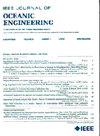LBL 水下定位系统的概念和精度验证
IF 3.8
2区 工程技术
Q1 ENGINEERING, CIVIL
引用次数: 0
摘要
本文详细介绍了一种创新的长基线定位系统的设计、部署和概念验证实验,该系统旨在为海底环境中的定位提供有效可行的解决方案。该系统提供了一种多功能和高效的替代方案,代表了海洋勘探和监测的重大进步。该系统的结构由四个漂流浮标组成,它们作为发射器,不限制接收器的数量,允许无限数量的用户连接,只要他们在船上安装了兼容的接收器。浮标上的发射器和水下接收器配备了声学调制解调器。发射机配备了全球导航卫星系统(GNSS)接收器,可以知道它们的位置,并通过地面通信执行系统精确同步的LoRa(远程无线电频率数据通信技术)收发器。为了验证该系统的有效性,在西班牙加的斯的“埃尔卡诺港”进行了测试,并在浅水中展示了其性能。这些有希望的结果强调了该系统在水下环境中提高定位精度和可靠性的潜力。本文章由计算机程序翻译,如有差异,请以英文原文为准。
Proof of Concept and Accuracy of an LBL Underwater Positioning System
This article details the design, deployment, and proof-of-concept experiment of an innovative long base line positioning system intended to provide an effective and viable solution for positioning in subsea environments. This system represents a significant advance in ocean exploration and monitoring by offering a versatile and efficient alternative. The system's architecture consists of four drifting buoys that function as transmitters, without imposing limitations on the number of receivers, allowing an unlimited number of users to be connected, provided they have compatible receivers installed on board. Transmitters on buoys and submerged receivers are equipped with acoustic modems. The transmitters are equipped with Global Navigation Satellite System (GNSS) receivers to know their positions, and LoRa (Long Range, which is a radio frequency data communications technology) transceivers that perform the precise synchronization of the system through surface communication. To validate the effectiveness of the system, tests were carried out in the “Puerto Elcano,” Cadiz, Spain, where its performance in shallow waters was demonstrated. These promising results underline the system's potential to improve positioning accuracy and reliability in subsea environments.
求助全文
通过发布文献求助,成功后即可免费获取论文全文。
去求助
来源期刊

IEEE Journal of Oceanic Engineering
工程技术-工程:大洋
CiteScore
9.60
自引率
12.20%
发文量
86
审稿时长
12 months
期刊介绍:
The IEEE Journal of Oceanic Engineering (ISSN 0364-9059) is the online-only quarterly publication of the IEEE Oceanic Engineering Society (IEEE OES). The scope of the Journal is the field of interest of the IEEE OES, which encompasses all aspects of science, engineering, and technology that address research, development, and operations pertaining to all bodies of water. This includes the creation of new capabilities and technologies from concept design through prototypes, testing, and operational systems to sense, explore, understand, develop, use, and responsibly manage natural resources.
 求助内容:
求助内容: 应助结果提醒方式:
应助结果提醒方式:


